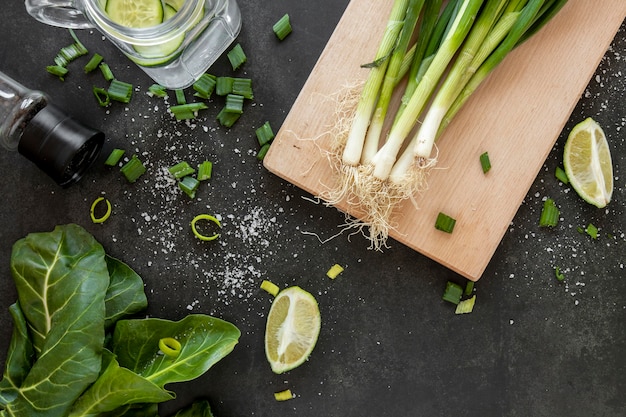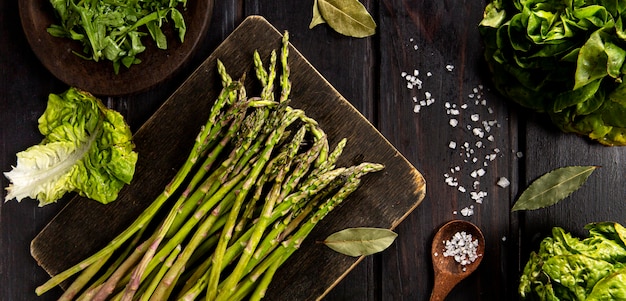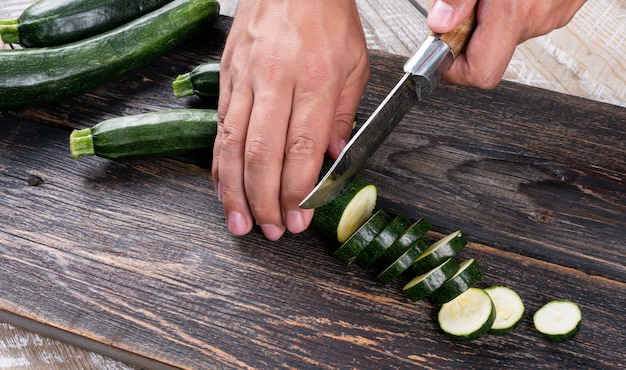Asparagus. Just the word conjures up images of sunny days, fresh air, and the delightful crunch of a perfectly cooked spear. It's a vegetable that holds a special place in my heart, a symbol of spring's arrival and the promise of culinary delights. But mastering asparagus isn't just about throwing it into a pan. It's about coaxing out its inherent sweetness and tenderness, achieving that delicate balance of flavour and texture that makes you sigh with satisfaction.
This guide is my love letter to asparagus, a culmination of years spent experimenting, learning, and indulging in this remarkable vegetable. We'll delve into choosing the perfect spears, exploring the secrets of prep and cooking methods, and even uncovering the science behind that famous "asparagus pee." So grab a glass of something chilled, settle in, and let's embark on this culinary adventure together.
(Part 1) Choosing the perfect asparagus

You wouldn't buy a dodgy sausage for your Sunday roast, would you? No, you'd want the best, the juiciest, most flavourful sausage you could find. The same principle applies to asparagus. You want the best possible spears to start with, the ones that promise a truly satisfying dining experience.
The Art of Spear Selection
First things first: firmness is key. You want asparagus spears that feel solid and springy when you gently squeeze them. Avoid any that are limp or floppy – they've lost their freshness and won't have the same satisfying snap.
Next, color matters. Look for spears with a vibrant, even green hue. Avoid those with dull green or yellowing tips, as they signify a decline in freshness and flavour.
Trimming the Ends and Understanding Thickness
Always check the ends. You'll often find dry, woody ends that will ruin the texture of your asparagus. Snip off about half an inch, or even more if the ends are particularly brown or withered.
Now, here's a bit of a secret: thickness matters. Thinner spears tend to cook more quickly and are ideal for salads or light preparations. Thicker spears, on the other hand, might benefit from peeling for a more even texture, a technique we'll explore in a bit.
Finding the Freshest Asparagus
Remember, fresh is best! While supermarkets offer convenience, nothing beats the vibrant freshness of locally sourced asparagus. If you can, head to a farmers market, where you can often chat with the grower and get their insider tips on selecting and cooking the perfect spears.
(Part 2) Getting Ready to Cook

You've got your asparagus, now it's time to get them ready for the culinary spotlight.
Washing and Trimming
Asparagus can harbour dirt and grit, so a thorough wash is essential. Gently run the spears under cool water, making sure to remove any lingering debris. Now, it's time for that final trim – snip off the ends, where the spears start to get woody and tough.
The Peeling Debate
Ah, the peeling dilemma! Some swear by it, especially for thicker spears. They say it removes a tough outer layer, resulting in a more tender, uniformly cooked asparagus. Personally, I usually skip peeling, but if you're feeling adventurous, peel a few spears and see if you notice a difference.
Ready to Cook
Your asparagus is now prepped and ready to become a culinary star. Store it in the fridge until you're ready to cook, keeping it crisp and fresh for the best results.
(Part 3) Cooking Methods: Unlocking the Potential

Asparagus is incredibly versatile, lending itself to a range of cooking methods, each highlighting a different facet of its flavour and texture.
Boiling: A Classic Approach
Boiling is the simplest way to cook asparagus. Fill a large pot with salted water, bring it to a rolling boil, and then gently add your asparagus spears. Cook them for about 3-5 minutes, depending on the thickness. You want them to be tender but still retain a bit of a snap.
Steaming: Preserving the Green
Steaming is a gentler method that helps preserve asparagus's vibrant green colour. Place the spears in a steamer basket over a pot of boiling water, cover, and steam for about 5-7 minutes. The steam will evenly cook the asparagus, producing a delicate and flavourful result.
Roasting: Adding Depth and Crispness
Roasting brings out asparagus's natural sweetness and delivers a slightly caramelized, crispy texture. Preheat your oven to 400 degrees Fahrenheit, toss the spears with olive oil, salt, and pepper, and spread them on a baking sheet. Roast for 10-12 minutes, until tender and lightly charred.
Grilling: A Smoky Delight
For a smoky flavour with a touch of char, grilling is the way to go. Preheat your grill to medium heat, toss the spears with olive oil, salt, and pepper, and place them on the grill. Cook for 5-7 minutes, turning occasionally, until tender and lightly charred.
Sautéing: A Quick and Easy Option
Sautéing is a quick and versatile way to cook asparagus, perfect for integrating it into various dishes. Heat olive oil in a skillet over medium heat, add the asparagus, and sauté for 5-7 minutes, stirring occasionally.
(Part 4) Flavour Fusion: Elevate Your Asparagus
You've chosen your asparagus, prepped it, and cooked it. Now, let's unlock the full potential of its flavour.
Simple Elegance
Sometimes, simplicity reigns supreme. A drizzle of olive oil, a squeeze of lemon juice, and a pinch of salt and pepper can create a timeless and satisfying combination that highlights the asparagus's natural flavour.
Bold and Exciting
But if you're seeking something more adventurous, consider a mustard-honey-balsamic vinaigrette. The tangy mustard, sweetness of honey, and acidity of balsamic vinegar will create a delightful symphony of flavours that dance on your palate.
Finishing Touches
For that extra touch of magic, don't forget the finishing touches. A sprinkle of grated Parmesan cheese, a scattering of toasted almonds, or a drizzle of truffle oil can elevate your asparagus to a whole new level of culinary excellence.
(Part 5) asparagus recipes: A Journey of Flavour
Let's move on to the heart of the matter: delicious asparagus recipes that will tantalize your taste buds.
Easy asparagus salad
This salad is a perfect example of simplicity at its finest. The roasted asparagus is tossed with a bright lemon dressing, feta cheese, and toasted pine nuts for a flavourful and satisfying experience.
Ingredients:
1 pound asparagus, trimmed
1/4 cup olive oil
2 tablespoons lemon juice
1/4 teaspoon salt
1/4 teaspoon black pepper
1/4 cup crumbled feta cheese
1/4 cup toasted pine nuts
Instructions:
1. Preheat your oven to 400 degrees Fahrenheit.
2. Toss the asparagus with olive oil, lemon juice, salt, and pepper on a baking sheet.
3. Roast for 10-12 minutes, until tender and lightly charred.
4. Top with feta cheese and toasted pine nuts.
5. Serve warm or at room temperature.
Asparagus and Mushroom Pasta
This pasta dish is a celebration of earthy flavours, combining the sweetness of asparagus, the umami richness of mushrooms, and the creamy depth of a white wine sauce.
Ingredients:
1 pound asparagus, trimmed
1 pound cremini mushrooms, sliced
1/4 cup olive oil
2 cloves garlic, minced
1/2 cup dry white wine
1/2 cup heavy cream
1/4 cup grated Parmesan cheese
1/4 teaspoon salt
1/4 teaspoon black pepper
1 pound pasta, cooked al dente
Instructions:
1. Bring a large pot of salted water to a boil. Add the pasta and cook according to package directions.
2. While the pasta cooks, heat olive oil in a large skillet over medium heat. Add the asparagus and mushrooms, sautéing for 5-7 minutes until tender.
3. Add the garlic and cook for 1 minute until fragrant.
4. Pour in the white wine and cook for 2 minutes until reduced by half.
5. Stir in the heavy cream, Parmesan cheese, salt, and pepper, and bring to a simmer.
6. Add the cooked pasta to the sauce, tossing to coat evenly.
7. Serve immediately.
Asparagus and Goat Cheese Tart
This tart offers a delightful blend of flavours and textures. The creamy goat cheese pairs beautifully with the roasted asparagus, while the flaky pie crust provides a satisfying base.
Ingredients:
1 pound asparagus, trimmed
1/4 cup olive oil
1/4 teaspoon salt
1/4 teaspoon black pepper
1 package (14.1 ounces) refrigerated pie crust
4 ounces goat cheese, crumbled
1/4 cup chopped fresh chives
Instructions:
1. Preheat oven to 375 degrees Fahrenheit.
2. Toss the asparagus with olive oil, salt, and pepper on a baking sheet.
3. Roast for 10-12 minutes until tender and lightly charred.
4. Place the pie crust in a pie plate.
5. Spread the goat cheese evenly over the bottom of the pie crust.
6. Arrange the roasted asparagus on top of the goat cheese.
7. Bake for 15-20 minutes, or until the crust is golden brown and the cheese is melted.
8. Garnish with chopped chives.
(Part 6) Wine Pairings: A Symphony of Flavours
Now, you've got your perfect asparagus recipe, but what about the perfect beverage to complement it?
Wine Choices
Asparagus, with its subtle bitterness and delicate sweetness, pairs beautifully with a range of wines.
White Wines: Sauvignon Blanc, Pinot Grigio, or Riesling. These crisp and refreshing wines enhance the asparagus's subtle notes, creating a harmonious experience.
Rosé Wines: A light and fruity rosé, like a Proven??al rosé, would be a wonderful match for the asparagus's delicate sweetness.
Red Wines: For a more robust pairing, consider a light-bodied red like Pinot Noir. Its fruity notes and delicate tannins will complement the asparagus's flavours beautifully.
Choosing the Right Wine
When selecting your wine, look for a bottle that's not overly oaky or heavy. You want a wine that will enhance the asparagus's flavor, not overpower it.
(Part 7) asparagus storage: Keeping it Fresh
You've got your asparagus, you've cooked it, you've enjoyed it – but what about any leftover spears?
Storing Leftover Asparagus
If you have leftover asparagus, it's best to store it in the fridge. Trim the ends, wrap the spears in a damp paper towel, and place them in a plastic bag. Store them in the refrigerator for up to 3 days.
Using Leftover Asparagus
Leftover asparagus can be incorporated into a variety of dishes. Add it to soups, stews, or salads. You can also sauté it with garlic and olive oil, roast it with other vegetables, or even use it to make a delicious frittata.
(Part 8) Asparagus Fun Facts: Unveiling the Mystery
Now, let's delve into some intriguing facts about asparagus and unlock some of its hidden secrets.
Fascinating Facts
Asparagus is a member of the lily family.
It's low in calories and packed with vitamins and minerals, including fibre, potassium, and vitamin K.
The scientific name for asparagus is Asparagus officinalis.
This delicious vegetable was first cultivated in ancient Egypt.
The Mystery of "Asparagus Pee"
Let's address the elephant in the room – the distinctive aroma that some experience after eating asparagus. Why does asparagus make pee smell funny?
The Science Behind the Smell
Asparagus contains a compound called asparagine. When your body breaks down asparagine, it produces a sulfur-containing compound called methanethiol, which is responsible for the characteristic smell. However, not everyone can smell it. It's thought that people who can detect the asparagus pee have a specific gene that makes them more sensitive to methanethiol.
(Part 9) FAQs: Answering Your Questions
Now that you've gained valuable insight into the world of asparagus, let's address some frequently asked questions.
FAQs
- Why is my asparagus so tough? It might be because you didn't trim the tough ends properly, or because the asparagus wasn't fresh enough. Try buying your asparagus from a local farmer's market and make sure to trim the ends diligently. For thicker spears, peeling them before cooking can also help.
- How do I tell if asparagus is bad? If the asparagus is limp, wilted, or has brown, dry ends, it's probably not good anymore. You should also avoid asparagus that smells musty or has a slimy texture. fresh asparagus should be firm, crisp, and have bright green tips.
- How long does asparagus last? Fresh asparagus can last in the fridge for up to 3 days if it's stored properly. Wrap it in a damp paper towel, place it in a plastic bag, and store it in the refrigerator.
- Can I freeze asparagus? You can freeze asparagus, but it won't have the same texture as fresh asparagus. To freeze asparagus, blanch it in boiling water for 2 minutes, then plunge it into ice water to stop the cooking process. Drain the asparagus, pat it dry, place it in freezer bags, and freeze for up to 6 months. Frozen asparagus can be added to soups, stews, or casseroles.
- What's the best way to cook asparagus? The best way to cook asparagus depends on your personal preference. If you like your asparagus tender and slightly crispy, try roasting or grilling it. If you prefer a more delicate texture, try steaming or boiling it. You can also sauté asparagus with garlic and olive oil or add it to stir-fries or salads.
So there you have it, a comprehensive guide to asparagus, from choosing the perfect spears to unlocking its culinary potential. Now, go forth and embrace the joys of this delicious and versatile springtime vegetable!
Everyone is watching

Perfect Rice Every Time: The Ultimate Guide to Cooking Rice
Cooking TipsAs a self-proclaimed foodie, I've always been a bit obsessed with rice. It's the foundation of countless cuisi...

Prime Rib Roast Cooking Time Chart: Per Pound Guide
Cooking TipsPrime rib roast. Just the name conjures images of lavish dinners, crackling fires, and hearty laughter. It’s ...

The Ultimate Guide to Cooking Asparagus: Tips, Techniques, and Recipes
Cooking TipsAsparagus. The mere mention of this spring delicacy conjures up images of vibrant green spears, crisp and burs...

Ultimate Guide to Cooking the Perfect Thanksgiving Turkey
Cooking TipsThanksgiving. Just the word conjures up images of overflowing tables laden with delicious food, the scent of r...

How Long to Bake Potatoes in the Oven (Perfect Every Time)
Cooking TipsBaked potatoes are a staple in my kitchen. They're incredibly versatile, delicious, and surprisingly easy to m...
